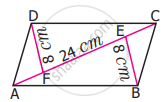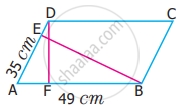Advertisements
Advertisements
Question
A parallelogram has sides of 20 cm and 30 cm. If the distance between its shorter sides is 15 cm; find the distance between the longer sides.
Solution

Let ABCD be the ||gm in which BC = 30 cm
and CD = 20 cm
Distance between shorter sides,
i.e. CQ = 15 cm
∴ area of ||gm = AB × CQ
= 20 × 15
= 300 cm2
Again BC × AP = Area of || gm
30 × AP = 300
AP = `300/30`
AP = 10 cm
∴ Distance between larger sides is = 10 cm
APPEARS IN
RELATED QUESTIONS
Area of a parallelogram is 83.2 sq cm. If its height is 6.4 cm, find the length of its base.
A parallelogram has sides of 15 cm and 12 cm; if the distance between the 15 cm sides is 6 cm; find the distance between 12 cm sides.
The base of the parallelogram with area is 52 sq.cm and height 4 cm is
What happens to the area of the parallelogram if the base is increased 2 times and the height is halved?
A square and a parallelogram have the same area. If the side of the square is 48 m and the height of the parallelogram is 18 m. Find the length of the base of the parallelogram
If the base and height of a parallelogram are in the ratio 7 : 3 and the height is 45 cm, then fixed the area of the parallelogram
Find the area of the parallelogram ABCD if AC is 24 cm and BE = DF = 8 cm
The area of the parallelogram ABCD is 1470 sq.cm. If AB = 49 cm and AD = 35 cm then, find the height, DF and BE
If the sides of a parallelogram are increased to twice its original lengths, how much will the perimeter of the new parallelogram?
ABCD is a parallelogram in which AE is perpendicular to CD as shown in the given figure. Also, AC = 5 cm, DE = 4 cm and area of ΔAED = 6 cm2. Find the perimeter and area of parallelogram ABCD.
